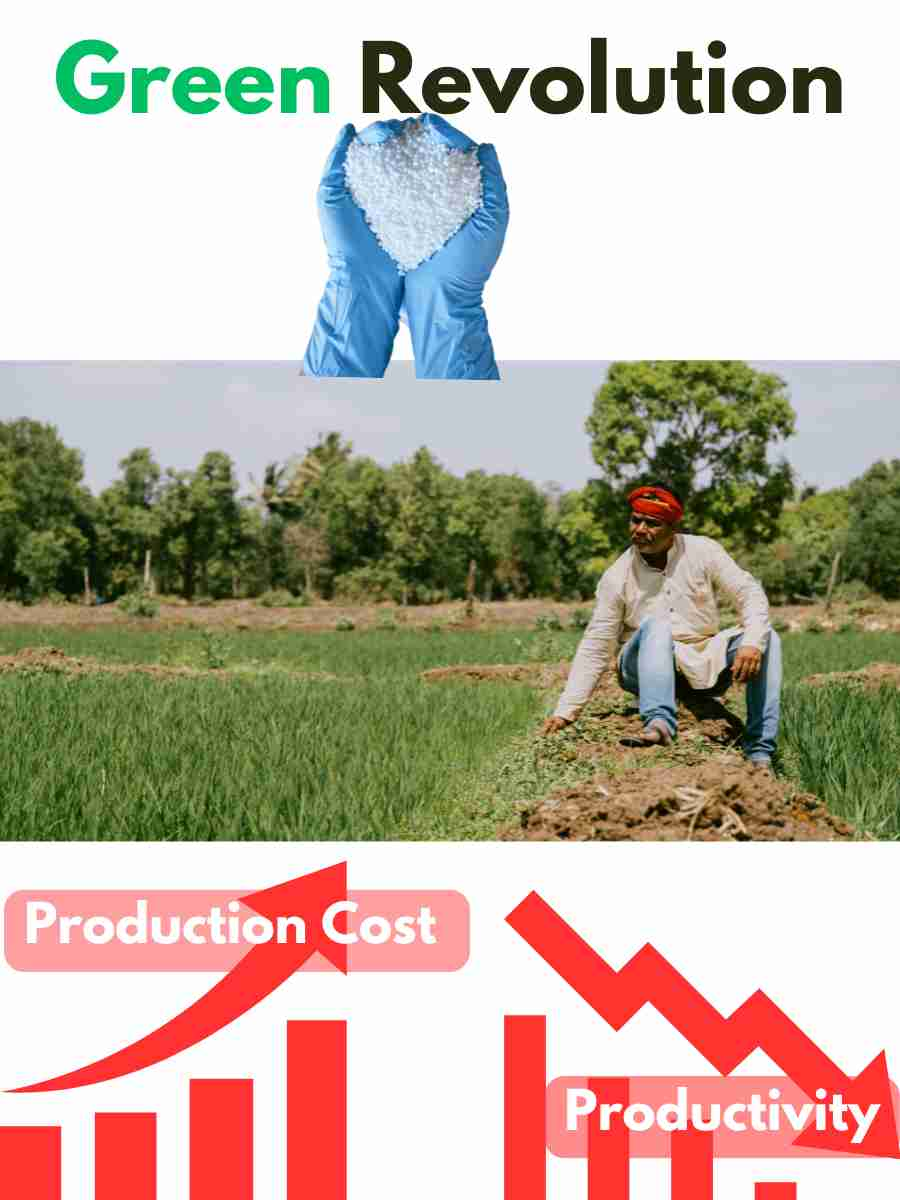
- Posted by : Admin
- On 08-Jul-2024
Impact of Green Revolution
The production of food within India was insufficient in the years from 1947 to 1960 as there was a growing population, during which a famine was also anticipated (Nelson et al., 2019). Food availability was only 417 g per day per person (Ghosh, 2002). Many farmers were in debt, and they had become landless laborers. Political situations that prevailed also had a negative impact on the food system. There was a severe shortage of food crops as well as commercial crops. At the same time, Norman Borlaug, an agronomist, contributed to the green revolution significantly, and this had set out its effects throughout the world. He provided new seeds for cultivation, which were stocky, disease-resistant, fast-growing, and highly responsive to fertilizers. In India, the green revolution was launched under the guidance of geneticist Dr. M. S. Swaminathan (Somvanshi et al., 2020). It started around 1960s and helped in increasing food production in the country. The green revolution’s primary aim was to introduce high-yielding varieties (HYVs) of cereals to alleviate poverty and malnutrition (Nelson et al., 2019). Not to deny, the green revolution was capable of mitigating hunger and malnutrition in the short term as well (Davis et al., 2019).
What Is the Green Revolution?
The green revolution led to high productivity of crops through adapted measures, such as (1) increased area under farming, (2) double-cropping, which includes planting two crops rather than one, annually, (3) adoption of HYV of seeds, (4) highly increased use of inorganic fertilizers and pesticides, (5) improved irrigation facilities, and (6) improved farm implements and crop protection measures (Singh, 2000; Brainerd and Menon, 2014) and modifications in farm equipment. There was a high investment in crop research, infrastructure, market development, and appropriate policy support (Pingali, 2012). Efforts were made to improve the genetic component of traditional crops. This included selection for higher yield potential; wide adaptation to diverse environments; short growth duration; superior grain quality; resistance to biotic stress, insects, and pests; and resistance to abiotic stress, including drought and flooding (Khush, 2001). After the green revolution, the production of cereal crops tripled with only a 30% increase in the land area cultivated. This came true all over the world, with a few exceptions. In addition, there were significant impacts on poverty reduction and lower food prices. Studies also showed that without the green revolution, caloric availability would have declined by around 11–13%. These efforts benefitted all consumers in the world, particularly the poor. There were further improved returns to the crop improvement research. It also prevented the conversion of thousands of hectares of land for agriculture (Pingali, 2012). The green revolution helped India move from a state of importing grains to a state of self-sufficiency (Brainerd and Menon, 2014). Earlier, it was the ship-to-mouth system, i.e., India depended on imported food items (Ramachandran and Kalaivani, 2018). There are undoubtedly positive effects on the overall food security in India. Correspondingly, useful and elaborate evidence in support of the positive impact of the green revolution is available. However, after a certain period, some unintended but adverse effects of the green revolution were noticed. This paper introspects the negative impacts of the green revolution on the food system in India. Studies by the departments of conventional agriculture, social sector development, etc. bring out the positive impacts of the green revolution, such as increased yield and reduced mortality and malnutrition (Somvanshi et al., 2020; von der Goltz et al., 2020). On the other hand, studies conducted by the environmental and public health departments suggest that to mitigate the negative impacts, a reduced usage of pesticides is sufficient (Gerage et al., 2017). There are many studies being conducted to find out the extent of the impacts of pesticides and insecticides and other similar chemicals.
Although there are many studies that focused on this topic, this paper makes an effort to inform policy by asserting that many interventions, beneficial for the shorter term, such as the green revolution, without the consideration of ecological principles, can be detrimental and irreversible in the long run (Clasen et al., 2019). Efforts to recover from environmental damage would require extensive efforts, time, and other resources as compared with the destruction of the environment. Hence, any new intervention needs to be checked for its eco-friendliness and sustainability features.
Carrying forward intensified usage of pesticides is not advisable in an ever-deteriorating environment, and alternative solutions that can promote economic growth, increased yield, and less harm to the environment can be implemented. The vicious cycle of problem-solution-negative impacts has to be broken at some point of time. For example, a second green revolution is focused on in various countries (Ameen and Raza, 2017; Armanda et al., 2019). Instead of this, techniques to promote sustainable agriculture can be considered. Hence, there has to be a wake-up call before the repetition of history.
- The heavy use of chemical fertilizers and pesticides reduced soil fertility and increased water pollution.
- The intensive use of water for irrigation depleted groundwater and over-extracted surface water.
- The focus on a few high-yield crops reduced biodiversity, making the agricultural system more vulnerable to pests and diseases.
- The Green Revolution increased economic disparities in rural areas, benefiting wealthier farmers with access to resources.
- The use of pesticides increased the presence of pesticide residues in foods and the environment. Long-term exposure to pesticides has been correlated with higher cancer rates.
- India lost almost 1 lakh varieties of indigenous rice, and there was reduced cultivation of indigenous varieties of millets and lentils.
- The high cost of inputs such as seeds, fertilizers, and pesticides has led many farmers to fall into debt.
- The benefits of the Green Revolution have been unevenly distributed, with some regions benefiting more than others.
BUILD YOUR BRIGHT FUTURE BY FARMING MUSHROOMS, WE ARE TO HELP YOU.

© 2025 Copyright nikkagro.com All right reserved.


